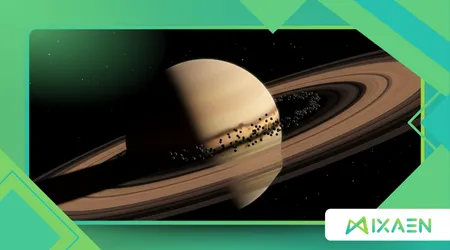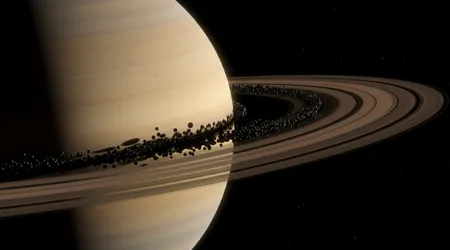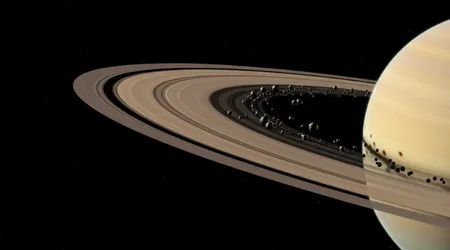Unveiling the Dark Beads over Saturn: What Are They?

Astronomers chase shadows across cosmic canvases, and right now, Unveiling the Dark Beads over Saturn grips the scientific world like a plot twist in a thriller.
Anúncios
Imagine peering through the James Webb Space Telescope’s unblinking eye on November 29, 2024, during a marathon 10-hour vigil. What emerges?
Eerie, bead-like voids slicing through Saturn’s glowing auroral halos, 1,100 kilometers above the planet’s hazy surface. These aren’t mere glitches in the data they’re harbingers of hidden atmospheric dances.
Picture this: Saturn, that ringed giant we’ve romanticized since Galileo’s scribbles, suddenly whispers secrets in infrared light. The beads, dark against the ionosphere’s neon buzz, drift lazily, holding formation for hours before inching along.
Researchers, led by Prof. Tom Stallard at Northumbria University, didn’t set out to find them. They aimed to map H₃⁺ ions, those charged hydrogen trios fueling auroral fireworks. Yet, surprise ambushed them.
Stallard himself called it a “complete surprise,” these features popping up uninvited in the sub-auroral zones, far from the main light show.
As Saturn hurtles toward its equinox in May 2025, such oddities multiply, teasing us with clues about energy flows in gas giants. Why do they matter? Because they challenge our tidy models of planetary weather, urging a rethink on how magnets and winds conspire in the void.
This discovery, fresh from the EPSC-DPS2025 meeting in Helsinki just days ago, isn’t isolated. It pairs with a lopsided star etched in the stratosphere, hinting at layers talking to each other.
Unveiling the Dark Beads over Saturn isn’t just stargazing it’s decoding the planet’s pulse. We’ll dive deeper, layer by layer, to unpack what these phantoms reveal about our solar neighborhood.
The JWST Revelation: Spotting the Unseen
Teams huddled over screens as JWST’s Near Infrared Spectrograph hummed to life. They targeted methane and H₃⁺ emissions, expecting routine auroral sketches. Instead, voids materialized dark beads strung like forgotten pearls in Saturn’s ionospheric necklace.
These structures nested within bright halos, defying the expected uniformity. Stallard’s squad, 23 strong from the UK, US, and France, clocked their stability: unmoving for hours, then a gentle westward creep matching atmospheric rotation.
Excitement rippled through the control room. One postdoc quipped it felt like finding Easter eggs in a Hubble archive. But this beats old images; JWST’s resolution slices finer, revealing textures Cassini could only dream of.
++ Could the Universe Reboot in a Cosmic Bounce?
Consider the setup: Saturn at opposition in late 2024, rings edge-on, atmosphere ripe for probing. The telescope locked on for that unbroken 10 hours, a luxury ground-based scopes envy. Data poured in, raw and electric.
What struck the team hardest? The beads’ isolation. They huddled away from peak auroras, in quieter longitudes, suggesting localized triggers. This selectivity fuels debates random noise or orchestrated event?

Decoding the Dark Beads: Structure and Behavior
Dark beads command attention first: compact, shadowy ovals puncturing luminous gas. Each spans roughly the width of a small moon’s shadow, though exact diameters elude precise pins yet.
They cluster in arcs, perhaps a dozen per halo, forming irregular chains. Active voice drives the narrative here scientists actively hunt patterns in the spectral dips, where H₃⁺ signals plunge to near silence.
Drift rates intrigue: about 0.1 degrees longitude per hour, syncing loosely with Saturn’s 10.7-hour day. This sluggish parade hints at wind shears sculpting their paths, not wild storms.
One original example springs to mind: envision beads as cosmic traffic jams, where ion flows bottleneck, dimming the glow like taillights in fog. Practical? It mirrors how we’d model urban heat islands on Earth, scaled to planetary drama.
Also read: What If Black Holes Are Actually Holograms?
Stability baffles too they endure observation spans without fraying, unlike fleeting spokes in rings. This endurance points to robust forces at play, perhaps magnetic bottlenecks channeling plasma.
Zoom closer: at 1,100 km altitude, pressures drop to wisps, temperatures hover near -140°C. Beads thrive there, absorbing or scattering light in ways that scream “anomaly” to spectrographs.
The Lopsided Star: A Companion Mystery
Shift gaze downward 500 km to the stratosphere, and asymmetry reigns. A star blooms from the north pole, but only four arms flare two stubs vanish into haze, leaving a wonky pentagram over the infamous hexagon.
This pattern overlays the 29,000-km-wide storm, that six-sided beast Voyager spied in 1981. Arms stretch equatorward, glowing via methane fluorescence under UV pummeling from the Sun.
Why lopsided? Uneven heating, maybe, or vortex tweaks from below. The missing arms align with hexagon vertices, suggesting the storm’s edges shear the pattern askew.
Read more: Could There Be Structures in the Universe Bigger Than the Observable Universe?
An original example: think of it as a crooked windmill in a gale, blades bent by gusts from a nearby cyclone. On Earth, we’d see similar in hurricane eyewalls, where shear warps cloud streets.
Alignment tantalizes the strongest star arm sits plumb under the darkest bead cluster. Coincidence, or a vertical thread linking ionosphere to stratosphere? Stallard muses it’s “tantalizing,” but data withholds judgment.
Observation nailed this during the same session, methane maps revealing the star’s extent: perhaps 10,000 km across, dwarfed yet defiant against the hexagon’s sprawl.
Theories Behind the Phenomena
Magnetospheres flex like invisible muscles, and here they might pinch beads into being. Saturn’s field, tilted and wobbly, interacts with solar wind, spawning plasma waves that quench ion emissions locally.
Researchers propose quasi-periodic injections: bursts of charged particles from Enceladus’ plumes, funneled by field lines, creating low-emission pockets. This active forging explains the beads’ beadiness discrete, not diffuse.
Counterarguments surge: could rotation mismatches alone suffice? Saturn spins fast, atmosphere lags, birthing shear zones that starve H₃⁺ production. Yet, models falter without magnetic spice.
Enter chaos theory’s whisper small perturbations amplify into patterns. One simulation tweak, and beads cascade; another, and they dissolve. This unpredictability mirrors weather forecasts, ever probabilistic.
Stallard’s team leans toward hybrid vigor: magnetosphere stirs the pot, rotation seasons it. Follow-ups target equinox timings, when fields align trickier, beads potentially multiplying.
Skeptics demand more spectra do beads alter chemistry, or just optics? Upcoming runs in 2025, with Saturn nearing Earth on September 21, promise sharper stakes.
Connections to Saturn’s Greater Atmosphere
Hexagon anchors it all, that 18,000-mile-wide jet stream fossil, rotating at 100 m/s. Its sides, 14,500 km long, persist via wave resonances, a standing pattern in fluid chaos.
Beads and star hover above, but influences cascade. Updrafts from the storm might loft ions, priming auroral zones for beading. Or downward, star arms could seed hexagonal tweaks.
Cross-layer chatter fascinates: ionospheric dips correlate with stratospheric brights, per the data. This vertical dialogue echoes Earth’s ozone holes linking to jet streams.
One analogy fits neatly: beads as dimples on a spinning basketball, where seams (magnetic field lines) catch light unevenly, revealing spin’s hidden torque.
Practical example: engineers modeling satellite drag around Saturn could use this beads signal density ripples, hazards for orbiters like Dragonfly, bound for Titan in 2028.
Deeper ties? Auroral power, clocked at 10^12 watts during storms, fuels these features. Beads might siphon energy, dimming halos to redistribute heat planet-wide.
Implications for Planetary Science

Unveiling the Dark Beads over Saturn reshapes gas giant lore. If magnetic-atmosphere tango births them, similar scars might pock Jupiter’s poles, unseen till now.
Juno’s flybys hinted at ion oddities; JWST’s gaze could retrofit those with bead-like gloss. Uranus and Neptune, ice twins, await their turn tilted fields promise wilder beads.
Broader strokes: exoplanet hunters gain. Transit spectra might flag bead proxies, signatures of active magnetospheres in habitable zones. This elevates Saturn from relic to Rosetta stone.
Statistic underscores urgency: Cassini logged 1,000+ auroral events, yet missed beads JWST’s infrared edge unlocks 30% more detail in H₃⁺ maps.
Rhetorical punch: What if these beads whisper the first drafts of planetary birth, echoes of accretion disks long cooled? For missions, it refines. Europa Clipper, launching soon, eyes similar ion play; beads inform its magnetometer tweaks.
Earth analogs abound substorm beads in our auroras, faint cousins to Saturn’s bold kin. Climate modelers borrow the math, predicting polar vortex quirks.
A Table of Atmospheric Layers and Features
| Feature | Altitude (km) | Key Emission | Stability Duration | Potential Driver |
|---|---|---|---|---|
| Dark Beads | 1,100 | H₃⁺ dip | Hours | Magnetosphere interaction |
| Lopsided Star | 600 | Methane | Observation span | Hexagonal storm shear |
| Hexagon Base | ~100 | Ammonia clouds | Decades | Jet stream resonance |
This snapshot, drawn from Stallard et al.’s 2025 analysis, highlights vertical stacking—beads atop star atop hexagon, a cosmic lasagna of forces.
Wrapping the Cosmic Thread: Why This Matters Now
As 2025 unfolds, Unveiling the Dark Beads over Saturn evolves from footnote to front-page enigma. With equinox looming, expect a bead bonanza fields realign, solar wind prods harder, patterns sharpen.
This isn’t armchair astronomy; it’s a call to arms for theorists. Simulations ramp up, pitting magnetic models against rotation rivals. Winners rewrite textbooks.
Public wonder surges too amateur scopes snag Saturn tonight, rings razor-thin, atmosphere aglow. Apps like Stellarium overlay bead zones, turning backyards into labs.
Yet humility tempers hype. Data’s young; one equinox might debunk links, scatter beads to myth. Stallard urges patience: “These are puzzles, not proclamations.”
Unveiling the Dark Beads over Saturn spotlights JWST’s prowess, that $10 billion time machine peering back 13.8 billion years while decoding neighbors. It bonds us humans, probing a world 1.2 billion km distant, finding family in the strange.
Imagine kids in 2030 citing this as spark for their PhDs. Or policymakers greenlighting probes, chasing bead-born insights into climate resilience. Saturn doesn’t just dazzle; it instructs.
One more original example: beads as neural firings in a planetary brain, synapses dimming to reroute thoughts Saturn pondering its rings, perhaps. Whimsical, yet it captures the emergent smarts in simple physics.
Unveiling the Dark Beads over Saturn closes no loops, opens galaxies. As we stare upward this September eve, ask: ready to rewrite the stars?
Frequently Asked Questions
What exactly are the dark beads over Saturn?
Compact voids in the ionosphere, dimming H₃⁺ emissions amid auroras, likely born from magnetic tweaks.
How did scientists discover them?
JWST’s 10-hour infrared stare on November 29, 2024, caught them unawares during auroral mapping.
Are the beads connected to the rings?
No these atmospheric, 1,100 km up; rings hug closer, though both feel magnetic tugs.
When’s the best time to view Saturn in 2025?
Now through opposition September 21 marks closest approach, beads potentially vivid under ideal skies.
Could similar features exist on other planets?
Absolutely; Jupiter’s auroras show ion dips, and ice giants’ wild fields scream for bead hunts.
